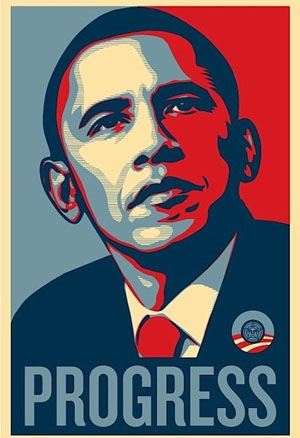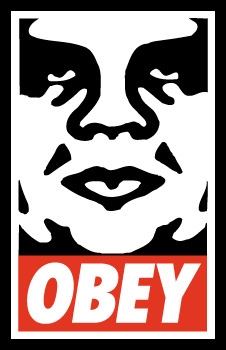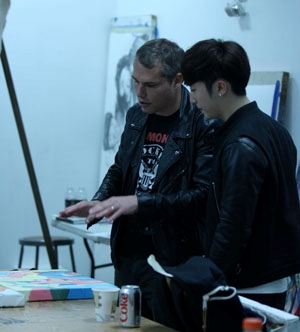 |
| Shepard Fairey addresses students and faculty at Idyllwild Arts Academy |
Shortly before taking the stage as a guest lecturer, Fairey reflected on his art school experience. "This was the first place that teachers were more like peers with experience than rules and dictators," he said. "They were not condescending, they were nurturing. They made me feel like they respected my opinion. I'm excited to share my work with students to keep the cycle of inspiration going."
 |
| Obama Poster (obeygiant.com (Shepard Fairey)) |
"That's what sort of kind of set me on a path towards the kind of graphic art that I still make." I didn't see that as art in the way it was defined around it so it was just a way of using skills I'd developed as an artist to make cultural artifacts that were important to me," he said.
Later, when he was a student at the Rhode Island School of Design (RISD), and a friend wanted to learn the stenciling technique, Fairey used to make his stickers. Fairey searched the newspaper for a suitable image to use as a teaching example and suggested his friend work with a photograph of pro wrestler Andre the Giant. His friend scoffed at the idea but Fairey thought it was an interesting image. Using what he now calls "primitive" techniques, Fairey created a sticker that would prove to be the foundation of his work for the next 20 years.
The sticker showed an image of Andre photo, with his reputed height and weight and the text, "Andre the Giant Has a Posse." Fairey printed a few hundred stickers and started posting them anywhere he could: on stop signs, in skate shops and in punk clubs. Soon, a local paper ran a photo of the sticker, sending it to its even broader readership.
Fairey began studying the way people engage with the images around them. "Images in public spaces that aren't advertising make people curious," said Fairey. With this sticker campaign he, "created a dialogue I hoped others would join in." He also wanted to expand the scale of his work beyond stickers and posters. "I learned that size is important to impact," he said.
He began using private buildings as well as public spaces as his canvas. Fairey's images began showing up on the backs of street signs, billboards and bus stops. By the early 1990s, Fairey's work could be found in cities around the world.
In his senior year, 1988, Fairey and his classmates took a field trip to Los Angeles to the Museum of Contemporary Art's Temporary Contemporary exhibit. The museum was featuring works by Andy Warhol and Roy Lichtenstein but what caught Fairey's eye were images of Ronald Reagan placed on downtown electrical boxes by Robbie Conal, a guerrilla poster artist, known for his unflattering depictions of political figures.
"Seeing that work strategically placed around downtown for all the public to see but also near MOCA, where MOCA patrons would see it, I thought it was a great way of engaging the public without any sort of bureaucratic boundaries and to also get the attention of the art crowd."
On the poster, Conal had placed the word "Contra" above the image and the word "Diction" below as a play on "Contragate," a political scandal, in which 11 officials in President Ronald Reagan's administration were convicted for the secret sale of arms to Iran. Fairey noted three key elements of Conal's work that he admired: artistic skill, social commentary and a sense of humor.
"He was using his art in a public way, making his statement," said Fairey. "When I saw Robbie's work, that was the kind of stuff I wanted to do. That was big for me."
 |
| Obey Giant (obeygiant.com (Shepard Fairey)) |
The Los Angeles museum was a long way from Charleston, South Carolina, where Fairey grew up in a more conservative environment. ""I went to a very, very oppressive private school where you had to wear a coat and tie," he said. "My mom was head cheerleader. My dad was captain of the football team."
In Charleston, Fairey found two outlets in which to channel his rebellious, creative energy: skateboarding and punk rock.
"Skateboarding was a physical outlet that was really creative," he said. "There's a whole, underground, do-it-yourself mentality to skateboarding. I could get a lot of physical aggression out but I could also make up tricks and bond with other people who felt marginalized and frustrated with society."
He found punk rock to be the perfect companion to skateboarding because, "it also had a component of social commentary in the rebellion," he said. "Some of which was very, very intelligent, well articulated."
He also loved to draw but rarely found time for it. "Only when I was on restriction from throwing water balloons at cars, or it was a rainy day," he said.
The creativity of the punk rock and skateboarding cultures, combined with his love for drawing, prompted him to create homemade stickers and t-shirts to share with his skater friends.
 |
| Fairey Works With a Student ( (Idyllwild Arts Academy)) |
The sticker drive evolved into the current OBEY GIANT campaign, which art teacher Mallory Cremin said, "has changed the way people view art in the urban landscape."
Strong iconic images are the cornerstone of Fairey's work. His 2008 poster of Barack Obama has been credited with helping to sway the presidential election. The OBEY giant web site (obey.com) even displays a thank you letter to Fairey from candidate Obama.
Part of OBEY's manifesto is to "awaken a sense of wonder about one's environment." "I'm trying to reach an audience that's not really predisposed to caring about art," said Fairey. "OBEY was about saying you need to deal with the concept of obedience and decide what you believe on a given issue,"
Fairey urges people to look beyond the images strategically placed before their eyes, especially by advertisers and political campaigns. "It's (advertising) powerful in its esthetics," said Fairey. "Packaged to seduce the viewer but often with a sinister agenda. My work looks sinister but it is benevolent, people may be able to see the other side of the coin."
Page created on 2/16/2012 9:27:44 PM
Last edited 7/22/2017 9:02:07 AM
